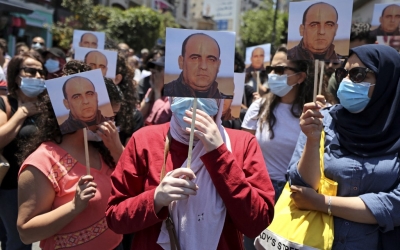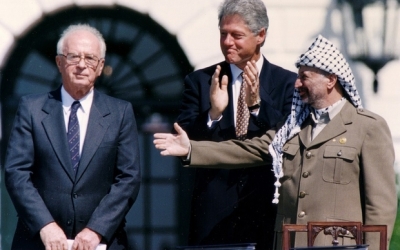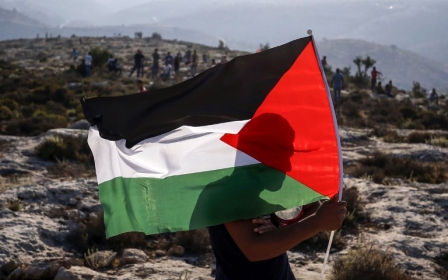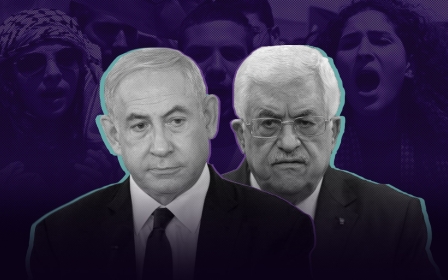Nizar Banat killing: Why the PA's days are numbered
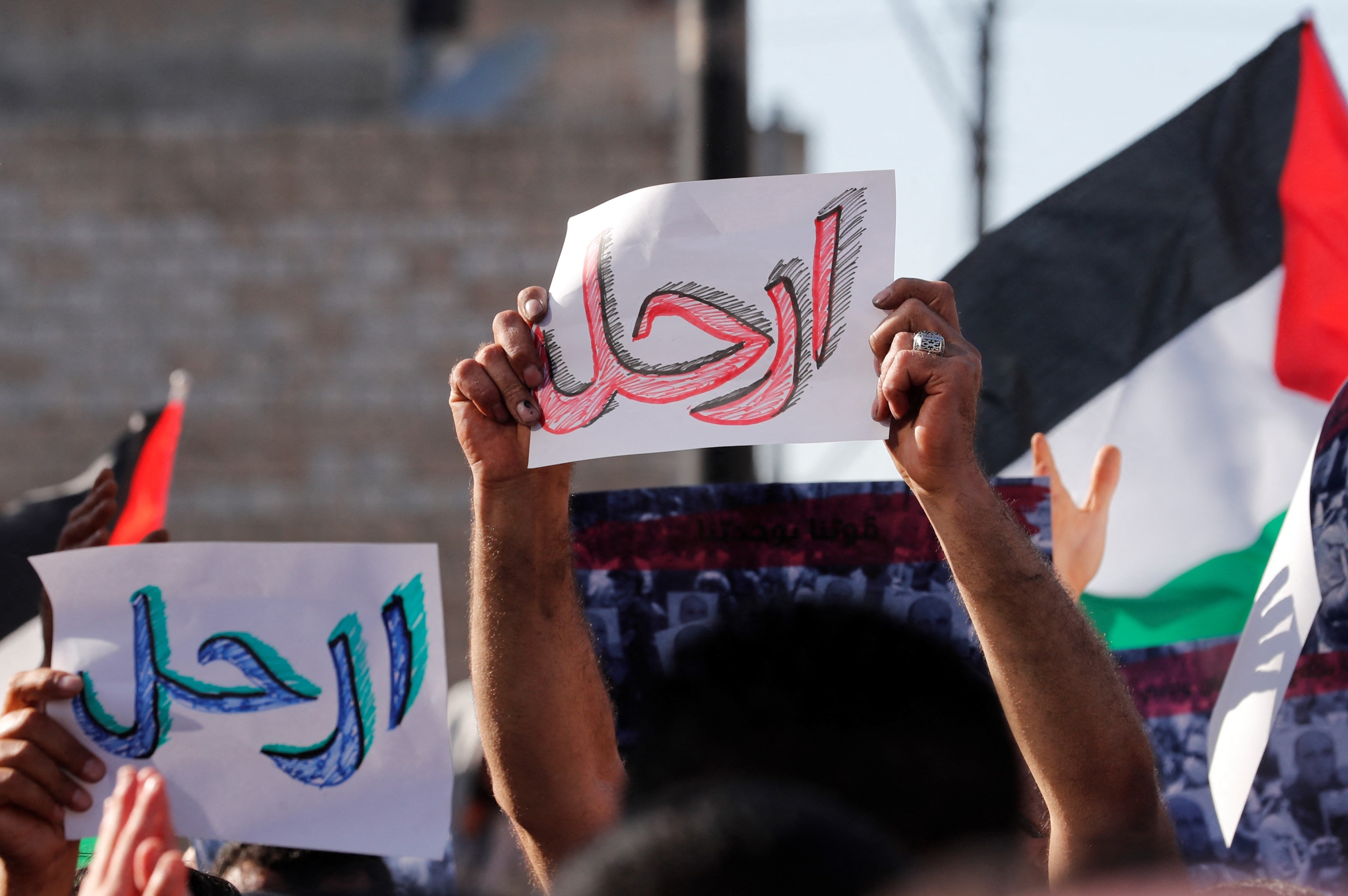
The horrific murder of Palestinian dissident Nizar Banat last week at the hands of the Palestinian Authority (PA) security forces is no more than the latest manifestation of the very reason that the PA was established through the September 1993 Oslo Accords as a collaborating body with the Israeli apartheid regime under US sponsorship.
Banat's murder is the latest manifestation of the very reason the PA was established as a collaborating body with the Israeli apartheid regime under US sponsorship
The Oslo Accords were followed by the Cairo agreement of May 1994, which stipulated under the heading "Palestinian Security" that "The Palestinian Police will operate under the auspices of the Palestinian Authority and will be responsible for internal security and public order. It will include 9,000 policemen, 7,000 of whom may come from abroad. The Palestinians will act to prevent terror against Israelis in the areas under their control."
This was the birth certificate of the PA mercenary force, which the Israelis charged with suppressing and killing the resisting Palestinians.
The arrangement was formalised again and extended in the Oslo II agreement, signed in Taba in September 1995 and witnessed four days later in Washington, with President Bill Clinton and the EU ambassador, among others, overseeing the ceremony, wherein the Israeli occupying army subcontracted "responsibility for public order and internal security" to "the Palestinian Police ..." beyond Gaza and Jericho to what was termed "Area A" of the West Bank.
The US and the EU (the latter at least since 2006) undertook the financing and training of the Palestinian police force, charged with repressing the Palestinian people and the protection of Israel's colonial regime.
New MEE newsletter: Jerusalem Dispatch
Sign up to get the latest insights and analysis on Israel-Palestine, alongside Turkey Unpacked and other MEE newsletters
Therefore, it seems quite remarkable that in the wake of Banat's murder by the police mercenaries they trained and funded, that the US and the EU waxed uncomfortable: the US State Department stated that Washington was "disturbed" by Banat's death: "We have serious concerns about Palestinian Authority restrictions on the exercise of freedom of expression by Palestinians and harassment of civil society activists and organizations."
While the EU trainers and funders of Banat's killers stated that they were “shocked and saddened by the death of activist and former legislative candidate Banat following his arrest by the PA security forces last night. Our thoughts go to his family and loved ones.”
It is unclear why the US and EU would be "disturbed", "shocked", or "saddened" when their trainees had performed the job for which they were created and for which the US and the EU funded and trained them all along.
Replicating apartheid
The PA police arrangement in fact replicated, and was perhaps inspired by, the South African apartheid state’s use of the Black police to suppress Black resistance before 1994, an arrangement that reduced the danger to the lives of white policemen.
Subcontracting the repressive functions of the Israeli military occupation to Palestinian mercenaries since 1993 was a welcome change for the Israelis, who continued to control the land, the waters, the borders, the economy, and Jewish settler-colonies, in short, everything Israel sought to control, but without the need to suppress Palestinian resistance single-handedly, which had endangered Israeli soldiers and opened Israel up to bad press in the process.
Then Prime Minister Yitzhak Rabin was explicit on this matter: "I’d rather the Palestinians coped with the problem of enforcing order in Gaza. The Palestinians will be better at it than we were, because they will allow no appeals to the Supreme Court and will prevent the [Israeli] Association for Civil Rights from criticizing conditions there by denying it access to the area. They will rule there by their own methods, freeing, and this is most important, the Israeli army from having to do what they will do."
In fact, the repressive function of the PA police had been already in evidence months before Arafat arrived in Gaza in July 1994. Three self-appointed traffic cops from the armed Fatah Hawks, which belonged to the Arafat wing of the PLO, ordered a motorist in Gaza in October 1993 to move his car. When he refused, they shot him in both legs.
Clyde Haberman, the New York Times Israel correspondent at the time, was concerned about the Palestinian police's abilities to protect Jewish colonial-settlers when they assumed authority. He asserted that "when that force comes into being in December [1993], it will have to prove its mettle. Certainly, it must show it can do better than [the] three self-appointed traffic cops…The Arab police must also show that [Jewish] Israelis living in and passing through the territories will be protected."
With this as precedent, and with Arafat and colleagues labeling all opponents of the Oslo surrender as extremists, then PLO ambassador to Tunisia and close Arafat advisor, Hakam Balawi promised on Israeli television to "crush" them. In November 1994, soon after entering Gaza, Arafat’s police killed at least 13 unarmed Palestinians and wounded 200 for daring to demonstrate against the Oslo Accords. During his visit to Gaza in early 1995, then US Vice-President Al Gore praised Arafat for setting up military tribunals to try those Palestinians opposed to Oslo.
US role
Whereas the CIA trained the PA police secretly at first, the US later fully assumed the responsibility for training them. Lieutenant General Keith Dayton, who served as the US security coordinator for the PA from December 2005 to October 2010, oversaw their training and the coup they staged against the democratically elected Hamas in 2007.
The PA security police have been a major Israeli success
In 2006, the US, according to Haaretz, began to train Abbas’s Praetorian Guard in Jericho for over a month with American, British, Egyptian, and Jordanian military instructors, and to provide them with weapons in preparation for a confrontation with Hamas to remove it from office after it was freely elected. The Israeli cabinet at the time approved the transfer of thousands of rifles from Egypt and Jordan to Abbas’s forces.
The Israelis also approved a US request that Israel allow the Badr Brigade - part of the Palestine Liberation Army then stationed in Jordan - to deploy in Gaza. These steps were conceived by General Dayton who wanted the Badr Brigade to function as Abbas’s "rapid reaction force in Gaza".
Before coming to the West Bank, Dayton was busy fighting America’s war against the Iraqi people in 2003. The European Union in turn has been financing and training PA police for the same tasks through their EU Coordinating Office for Palestinian Police Support or EUPOL COPPS since 2006.
The end is near
When Palestinian President Mahmoud Abbas recently cancelled the PA parliamentary elections scheduled for 22 May, Banat, who was a candidate on the independent Freedom and Dignity electoral list, appealed along with his list members to the EU courts, including the Court of Human Rights in Strasbourg, to order an immediate cessation of financial aid to the PA.
He had hoped that his appeal would force the EU to cease and desist from its ongoing support and training for the PA to repress Palestinians like himself. It is very likely that this was a major contributing factor to the decision taken by the PA mercenaries to put into practice once again what the US and the EU have trained them to do so well.
The US and EU should be proud of their achievement, as are the Israelis who continue to lavish praise on their PA security forces. Indeed, this is so because the PA security police have been a major Israeli success and are duly credited for continuously preventing the majority of Palestinian resistance operations against the occupation army and its settler-colonists.
The murder of Banat, however, has come at a time when the international legitimacy of the PA is at an all-time low in the wake of the heroic resistance of the Palestinian people across historic Palestine last month, resistance which the PA continues to suppress.
It may very well be that the end of the collaborationist PA is in sight. Its creators and funders now realise that it no longer has much sway over the Palestinian people. The PA can no longer use, as it did previously, its administrative, financial, and media arms (now exhausted) combined with its repressive police agencies to impose its authority in the West Bank.
All it has left today to impose its authority is its repressive agencies, as evidenced by the suppression last week of Palestinian demonstrators in the West Bank protesting the murder of Banat, whom it shot and beat, just as the PA police had done in Gaza at its inception back in 1994.
But no amount of killings or beatings can stop Palestinian resistance, a lesson that the Israelis, the boss of the PA, continue to learn the hard way.
The views expressed in this article belong to the author and do not necessarily reflect the editorial policy of Middle East Eye.
This article is available in French on Middle East Eye French edition.
Middle East Eye delivers independent and unrivalled coverage and analysis of the Middle East, North Africa and beyond. To learn more about republishing this content and the associated fees, please fill out this form. More about MEE can be found here.




